Types of Traps Used in Canada
Traps are responsible for unimaginable suffering for all animals who encounter them, whether they are ‘target’ or non-target animals (companion animals, endangered species, deer, birds, etc.). There are four main traps used in Canada today: the leg-hold, Conibear, snare trap and cuff-style trap. Leg-holds and cuff-style traps are ‘restraining’ traps, while Conibear and snare traps are designed to kill instantly. However, instantaneous death is not a guarantee with killing traps, resulting in excruciating pain for animals that become victim to these cruel devices.
1. The Leg-Hold Trap
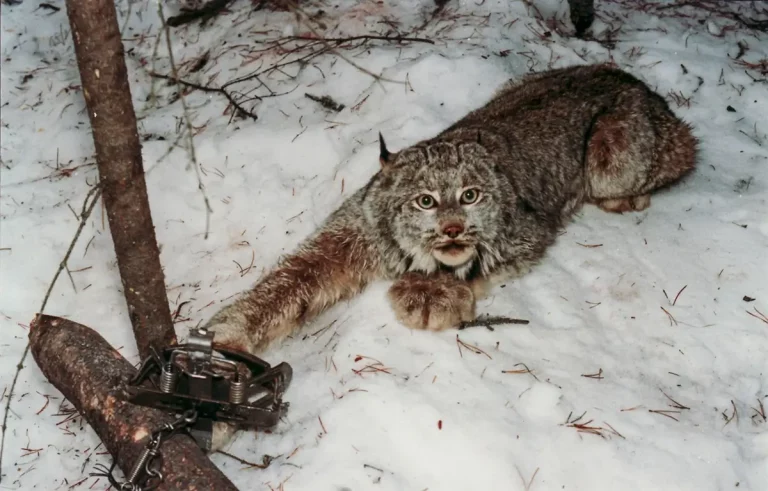
The leg-hold is referred to as a ‘restraining trap’. It is used primarily on foxes, coyotes, raccoons, wolves, lynx, and bobcats. These traps are placed in areas where animals are known to pass through and will catch the animal by the limb (ensuring the pelt remains unspoiled).
The leg-hold trap is comprised of a metal foot plate and curved jaws, powered by strong springs. It is usually anchored into the ground by a short chain and metal spike or is secured to a tree or a large branch.
Once triggered, the trap immobilizes the animal. This prevents them from eating and drinking, caring for their young, fending off predators, or sheltering themselves from the elements. Leg-hold traps are designed to hold a wild animal who does not want to be caught. In their distress and panic, some animals become so desperate to escape that they resort to chewing or wringing off their trapped limbs, breaking their teeth and bones in the process.
Animals endure a painful and panic-filled period until they either die from exhaustion, blood loss, predation, dehydration, hypothermia, or are clubbed, choked, or stomped to death by the trapper (so as not to damage the pelt).
The following are the most common models of leg-hold traps:
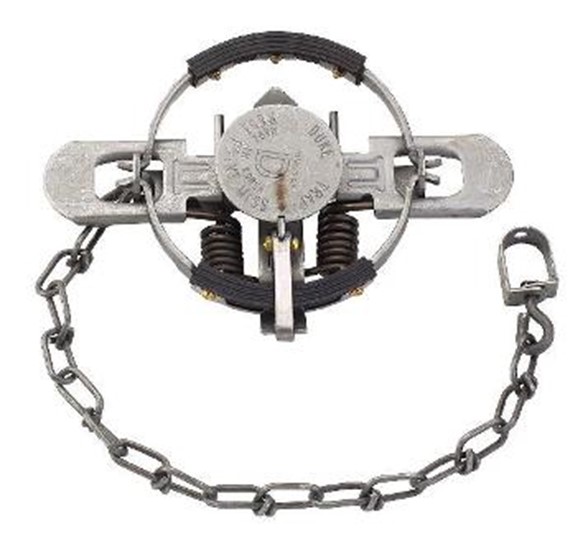
The so-called ‘padded’ trap clamps onto an animal’s leg with enough power to hold an adult wolf. The only difference between a padded trap and a regular steel jawed leg-hold trap is a strip of rubber lining the powerful steel jaws. This can be likened to slamming your hand in a car door. This trap is marketed by the fur industry as “humane”. |
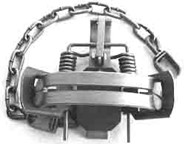
The offset trap is a regular steel jawed leg-hold trap with a 3/16” gap between the closed steel jaws. The small space was thought to allow for blood flow to the trapped limb. When blood flow is restricted, it numbs the trapped limb, increasing the likelihood of an animal chewing or wringing off their limb and escaping. |
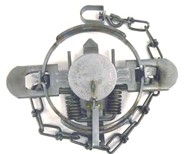
The laminated trap is a regular steel jawed leg-hold trap with extra steel added to the jaws to make them wider (thicker). The pressure of the jaws is spread over a larger area with the intention of allowing for increased blood flow. As described above, when blood flow is restricted, it numbs the trapped limb, increasing the likelihood of an animal chewing or wringing off their limb and escaping. |
Despite being banned in many countries around the world and several states in the US, the leg-hold trap is still legal in every province and territory in Canada (only leg-holds with ‘teeth’ have been prohibited). Every Canadian should know how to open a leg-hold trap in case of an emergency. The Fur-Bearers has provided a short video tutorial of how to open a leg-hold trap here.
2. The Conibear Trap
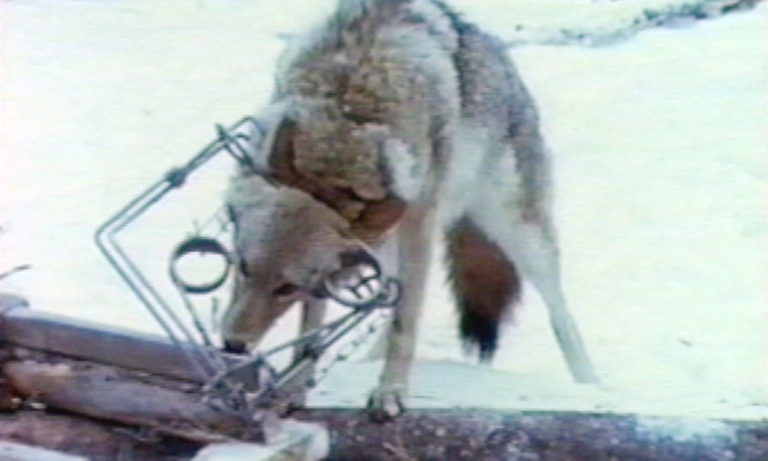
The Conibear trap was invented in 1957 by Frank Conibear, who wanted to create an alternative to leg-hold traps in order to kill animals instantly. The trap consists of two rectangular frames with a trigger, that when activated, slams shut on the body.
The design on this type of trap is inherently flawed, specifically as it relates to non-target animals. When animals walk or swim through it, they may be too large or too small for the trap. Because of this, when the trap gets triggered, it can clamp down on the animal without killing them, resulting in agonizing pain and a prolonged death. Even if the ‘target’ animal is the appropriate size for the trap, he or she needs to trigger the trap at the right speed and the right position for it to kill instantaneously, and even that might fail. Because of this, these traps do not consistently kill animals and should not be considered ‘humane’.
In a 2019 study that looked at the inadequacy of trap checking times in North American jurisdictions, the Conibear 120, along with killing neck snares, were used in the study precisely because they “fail to consistently and humanely kill furbearers.” The authors write:
Because these killing devices are not powerful enough for the target species, the trigger systems do not properly position the animals in traps, or trappers are inexperienced and improperly set traps or snares, these killing devices become restraining devices, and animals suffer long and painful deaths.¹
Despite this, as of 2021, the Conibear 120 is still a certified trap regulated for use for specific species in Canada.² Newer Conibear type traps (such as the Magnum and the Sauvageau) are available on the market, but all suffer the same inherent design flaws.
To compound this problem, in many Canadian provinces, a trapper can legally leave a Conibear trap unchecked for up to 14 days – an extraordinary amount of time for an animal to be held in a Conibear trap, immobilized, defenseless, and suffering in pain.
3. The Snare Trap
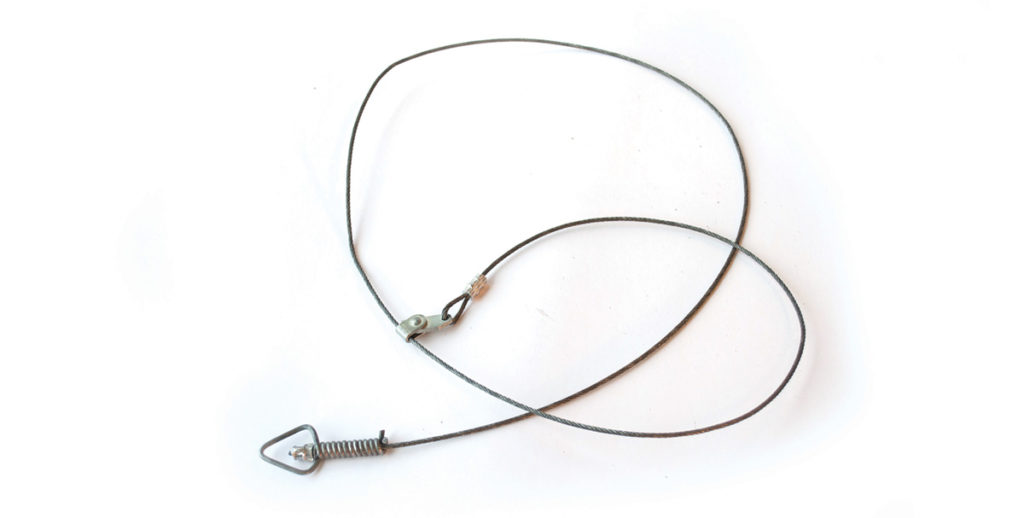
The snare is an indiscriminate and extremely cruel trap used primarily for coyotes, foxes, and wolves. Both neck and leg snares are routinely used in Canada.
The snare, though simple in design, causes immense suffering to any animal who encounters one. A wire loop is placed along a traveling path where the animal will walk through it. The snare tightens as the animal tries to free him or herself, resulting in restraint, or death by slow strangulation. Some animals struggle long enough for the snare to make it difficult to breathe, but not long enough to be killed.
Non-target animals are also at risk of being caught in snare traps. Ungulates, like deer or elk, can walk into the snare which grasps them by the leg. In the struggle to free themselves, they can break their limbs, which leaves them injured and vulnerable to predators. A woman living in Central Alberta who found her dog dead with his throat cut because of a snare trap also found carcasses of ungulates near her dog’s body, all victims of a snare trap set legally by a licensed trapper. The woman reported to CBC News:
"There was carcasses everywhere. A moose head, some deer legs, spines, mainly wildlife but there was even some farm animals were in there. And they put these wire-like cables in the bush around it, and hung them above the ground, and then the animals walk right into it."³
In another case in Alberta, neck snares set to catch wolves inadvertently killed 15 cougars and injured a pair of golden eagles. A wildlife specialist says the cougars likely suffered for days before they died.⁴ Sometimes the ensnared animal will manage to pull the snare from its stake in the ground, as has been documented in a case in Ontario where an adult black bear was spotted roaming with a snare around their neck.⁵ The wire in these snares can also become embedded in animals’ flesh, resulting in a prolonged, painful death through infection from the embedded trap.
4. Cuff-Style Traps
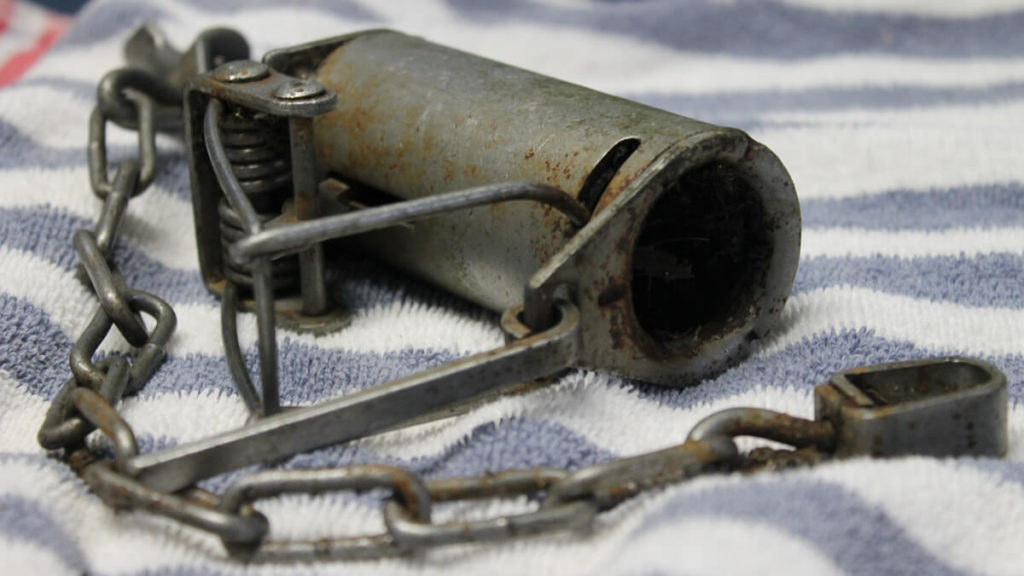
Cuff-style traps are restraining leg-hold traps and are often marketed as “dog-safe”, commonly used to trap raccoons. These traps are legal and can be bought by anyone without a license in many hunting and outdoors stores. Despite being marketed as “dog-safe”, these traps are inhumane and non-target animals are victims to these traps as well. In April 2021, a cat in Amherstburg, ON was found with his paw caught in one of these traps, which veterinarians said that his leg would likely need to be amputated as a result of his injuries. In 2018, a raccoon was found in a Burnaby, BC neighborhood with his foot caught in the trap. The raccoon chewed off his paw because of the incident and had to be euthanized.
The video below was taken on Galiano Island, BC in 2020. A mother raccoon was caught in a cuff trap and pulled it from the ground. She was at large with the trap on her paw for 5 days before being caught by rescuers and subsequently euthanized. Her kits were sent to a wildlife rehabilitation centre.
A Crying Shame
Our film, Crying Shame contains footage taken by a licensed trapper on a registered trapline during trapping season. The traps described above are depicted in this video, and all cameras were automatic (no humans approached the trapped animals).
References
¹Proulx, G., & Rodtka, D. (2019). Killing Traps and Snares in North America: The Need for Stricter Checking Time Periods. Animals : an open access journal from MDPI, 9(8), 570. https://doi.org/10.3390/ani9080570
²Fur Institute of Canada. Certified Traps List FIC, Update February 1, 2021. https://fur.ca/certified-traps/
³Snowdon, W. (2016, February 15) Coyote snares a ‘death trap’ for pets in Parkland County. CBC News. https://www.cbc.ca/news/canada/edmonton/coyote-snares-a-death-trap-for-pets-in-parkland-county-1.3448365
⁴Wood, D. (2016, March 9) Snares meat for wolves catch and kill 15 cougars and maim a pair of golden eagles. Calgary Herald. https://calgaryherald.com/news/local-news/snares-meant-for-wolves-catch-and-kill-15-cougars-and-maim-a-pair-of-golden-eagles
⁵CBC News Thunder Bay. (2012, October 5) Too hazardous to help wire-bound bear: MNR. CBC News. https://www.cbc.ca/news/canada/thunder-bay/too-hazardous-to-help-wire-bound-bear-mnr-1.1219210